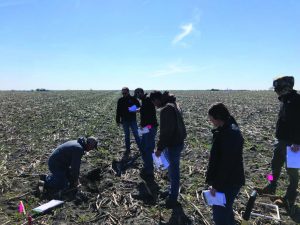R.F.D. NEWS & VIEWS: NRCS conservation programs setting records
By Tim Alexander for Chronicle Media — May 30, 2023
Members of the Illinois Sustainable Ag Partnership examine a crop fi eld’s soil structure in this
provided photo. ISAP is publishing a free fi nancial assistance guide for farmers interested in
bolstering their edge-of-fi eld nutrient loss reduction strategies.
With the focus on last week’s “SCOTUS WOTUS” ruling re-defining what can be considered a waterway of the U.S., we devote this week’s column to conservation efforts in agriculture. Please read on…
SCOTUS guts EPA’s WOTUS rule
BLOOMINGTON – Reaction to the U.S. Supreme Court’s ruling that the U.S. Environmental Protection Agency (EPA) overstepped their boundaries in deciding which waterways can be protected under the Clean Water Act was swift and passionate from both agriculture and conservation interests. Justice Samuel Alito, who authored the SCOTUS opinion, said the EPA misinterpreted the reach of the Clean Water Act when it classified the wetlands on property owned by Idaho couple Chantell and Michael Sackett as a “waterway of the U.S.,” or WOTUS. Wetlands can only be regulated under the Act if they have a “continuous surface connection to bodies that are ‘waters of the United States’ in their own right,’ so that they are ‘indistinguishable’ from those waters,” Alito opined.
Illinois Farm Bureau President Richard Guebert Jr. issued the following statement regarding the ruling: “Illinois Farm Bureau celebrates today’s unanimous decision by the Supreme Court regarding Sackett v. EPA, which confirms EPA overstepped its authority under the Clean Water Act by restricting private property owners from developing their land. Additionally, this ruling is the law of the land and directs the Biden administration to revisit WOTUS and issue a clear rule that doesn’t require farmers to hire a team of attorneys to care for their land.”
Environmental groups, including the Heart of Illinois Chapter of the Sierra Club, were outraged at the decision. HOI Sierra Club water program director Beth Roach said a five-Justice conservative majority is interfering with the EPA’s ability to protect U.S. waterways. “While this decision will make it more difficult to protect wetlands, the Sierra Club will not stop fighting and working every day to build the grassroots power to ensure clean water for all. Our programs, chapters, volunteer leaders, and grassroots activists across the country will work to engage in local, state, and national efforts to protect our water,” Roach said in an update to members.
According to CBS News, the court ruled unanimously in favor of the Idaho couple that brought the case, but split 5-4 in its reasoning.
“Edge of Field” incentive directory published
BLOOMINGTON – One way farmers can help keep field nutrients such as fertilizers that contain nitrates and phosphorus from reaching “waters of the U.S.,” or WOTUS, is to employ strong “edge of field” (EOF) practices that reduce runoff. However, costs associated with constructing strong EOF defenses can prohibit some producers from making that commitment.
A new publication, the Illinois Sustainable Ag Partnership’s (ISAP) Edge of Field Incentive Directory, provides a quick reference for farmers and conservation partners interested in programs that provide financial and technical assistance for EOF practice implementation in Illinois. These practices could include bioreactors, wetlands for tile drainage treatment, drainage water management, drainage water recycling, saturated buffers, vegetated riparian buffers, filter strips, prairie strips and restored wetlands.
“Incentive programs are exceptionally important for supporting the adoption and implementation of EOF conservation practices in Illinois and across our agricultural landscapes,” said Adrienne Marino, Water Quality Program Manager with The Nature Conservancy and member of ISAP’s Education Committee. “While benefits provided by EOF practices primarily occur downstream, landowners accrue lost production and installation costs that incentive programs can help offset.”
The directory includes information on publicly funded programs at the federal and state levels, as well as privately funded programs throughout Illinois. It also includes a “stacking matrix” to help users understand which programs can be combined to receive multiple incentives. The Edge of Field Incentive Directory and Stacking Matrix is available to view on ISAP’s website. (ISAP news)
NRCS conservation programs setting records
WASHINGTON, D.C. – Last week’s “SCOTUS WOTUS” decision (see top story) was met with great relief by many in the agriculture industry, but that doesn’t mean that U.S. farmers are shirking their land and water stewardship responsibilities. Thanks to funding created by the bipartisan Inflation Reduction Act (IRA), record numbers of farmers and rural landowners are signing up for key conservation programs through the USDA’s Natural Resources Conservation Service (NRCS).
“So far in fiscal year (FY) 2023, NRCS is ahead of historical rates in obligating financial assistance for conservation programs and has obligated more than 19,500 contracts, compared to an average of just over 12,000 at this same time over the last four years,” reported Terry Crosby, NRCS chief, in a May 23 USDA news release. “Since announcing the availability of FY 2023 IRA funds in February, we have had over 10,000 applications for IRA in EQIP (Environmental Quality Incentive Program) and CSP (Conservation Stewardship Program)—and that number is growing every day. We’re currently receiving an average of 29 IRA applications per hour for CSP and EQIP combined.”
In addition, NRCS has received $174 million in requests for $65 million in available funding for ACEP (Agricultural Conservation Easement Program) in FY ‘23. Funding allocations for ACEP are expected to be announced soon, according to Crosby.
Illinois Outdoor HOF nominations sought
SPRINGFIELD – The Illinois Conservation Foundation is accepting nominations for the 2023 Illinois Outdoor Hall of Fame class. The Foundation recognizes individuals who have records of exemplary service in and commitments to improving conservation efforts and outdoor recreation opportunities in Illinois. For more information, contact the Illinois Conservation Foundation at info@ilconservation.org or 217-785-2003. Additional information may be found online at https://ilconservation.org. (Illinois e-News)
Illinois Farm Fact:
Edge of field (EOF) practices are those practices which intercept, capture, and treat subsurface drainage (conservation drainage practices) or surface runoff at the field level. (Ill, Sustainable Ag Partnership)



